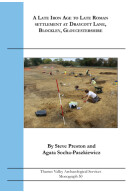Google Books previews are unavailable because you have chosen to turn off third party cookies for enhanced content. Visit our cookies page to review your cookie settings.
A Bronze Age Triple Ditch Barrow and Middle Iron Age Settlement at Wetstone Bridge Quarry, near Marston Meysey, Gloucestershire (Paperback)
Imprint: Thames Valley Archaeological Services
Series: TVAS Monograph Series
Pages: 90
ISBN: 9781911228479
Published: 29th June 2020
Script Academic & Professional
Series: TVAS Monograph Series
Pages: 90
ISBN: 9781911228479
Published: 29th June 2020
Script Academic & Professional
Usually available in 6-8 weeks.
You'll be £15.00 closer to your next £10.00 credit when you purchase A Bronze Age Triple Ditch Barrow and Middle Iron Age Settlement at Wetstone Bridge Quarry, near Marston Meysey, Gloucestershire. What's this?
+£4.99 UK Delivery or free UK delivery if order is over £40
(click here for international delivery rates)
Need a currency converter? Check XE.com for live rates
(click here for international delivery rates)
Need a currency converter? Check XE.com for live rates
This volume in the TVAS Monograph Series details archaeological excavations covering almost 18ha in advance of quarrying, in an area now extensively explored through many similar projects. The work primarily examined an extensive area of Iron Age occupation demonstrating repeated use of the same location from the 6th century BC down to the mid 1st century BC, with the chronology supported by radiocarbon dating. The settlement was unenclosed except that it lay on an isthmus of slightly higher ground bounded on two sides by palaeochannels. As many as 22 ring-gully house sites have been identified, some recut two, three or even four times on the same axis. A number of the ring gullies were integral with small enclosures (pens), and others contained entrances defined by short antennae ditches producing a 'banjo' form. Although the main complex itself was unenclosed, earlier phases of the use of this location included land division associated with more ring gullies and enclosures, remodelled at least once. Despite an extensive sampling programme, almost no charred cereal grains were recovered suggesting that the site was predominantly a pastoral farming endeavour, as is also suggested by older cattle forming an unusually high proportion of the faunal assemblage. The field boundaries may have been to assist dairy farming.
In addition an unusual triple ring monument was excavated. It contained no closely datable artefacts, burial deposits nor direct dating evidence, but was stratigraphically later than a waterlogged pit which produced a radiocarbon date of 2204-1965 cal BC. A dense cluster of pits and postholes including a roundhouse is thought to represent an area of Later Bronze Age occupation. Another isolated roundhouse is also of presumed Bronze Age date.
There is little evidence for use of the site after the Iron Age settlement was abandoned, until the digging of ditches, field boundaries and water meadows in late post-Medieval times. The site is considered in relation to other nearby excavations covering similar periods.
Other titles in the series...
Other titles in Thames Valley Archaeological Services...










